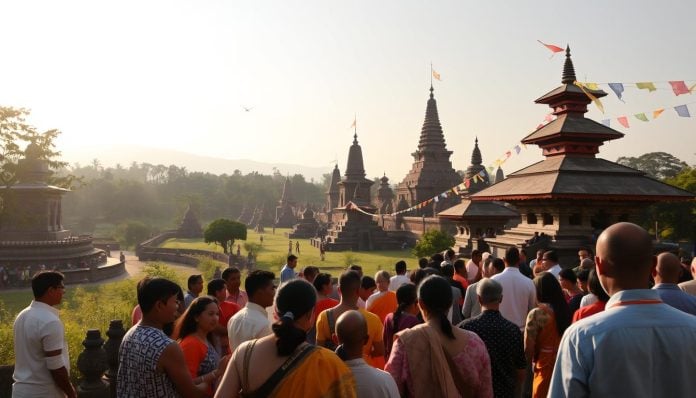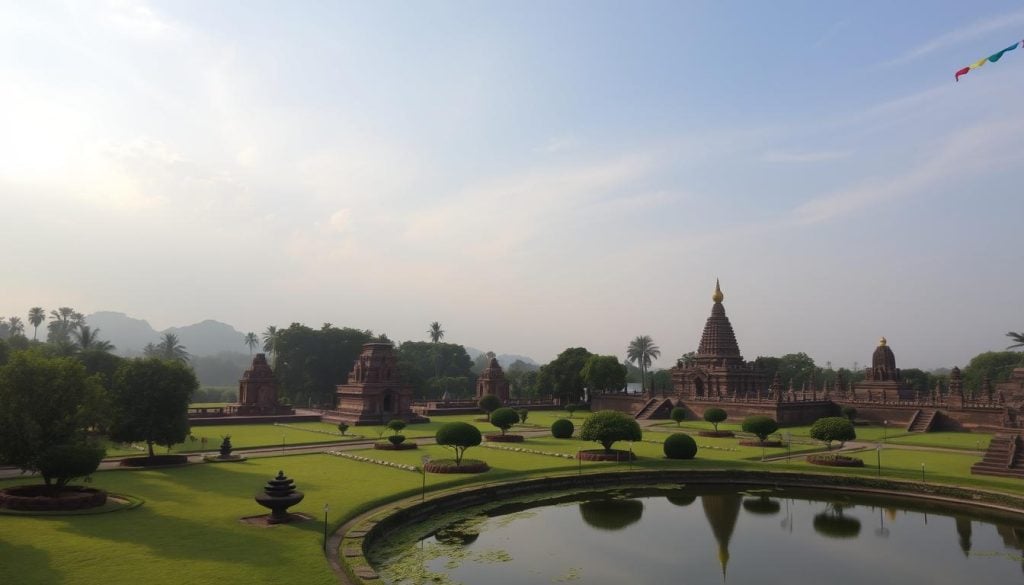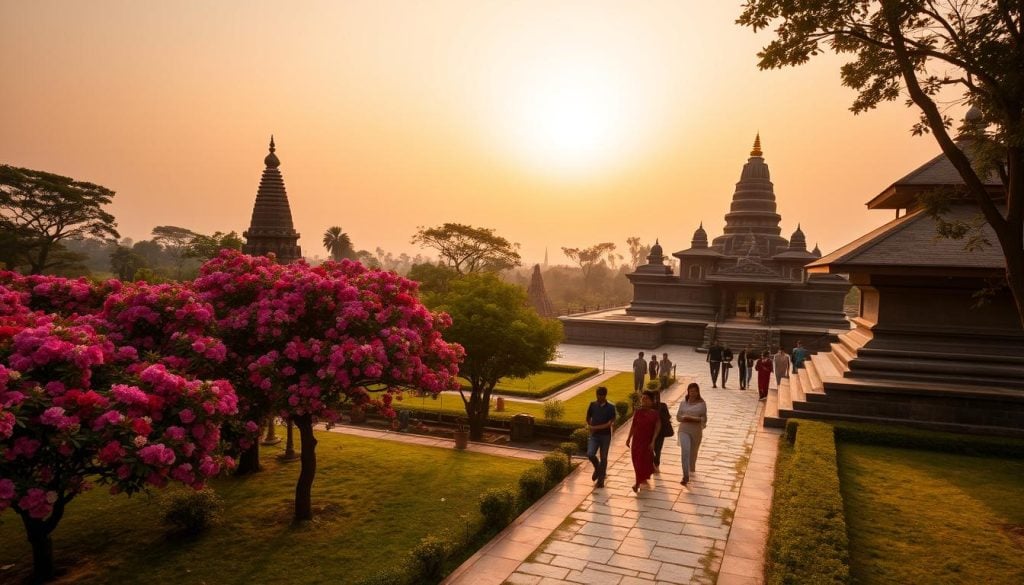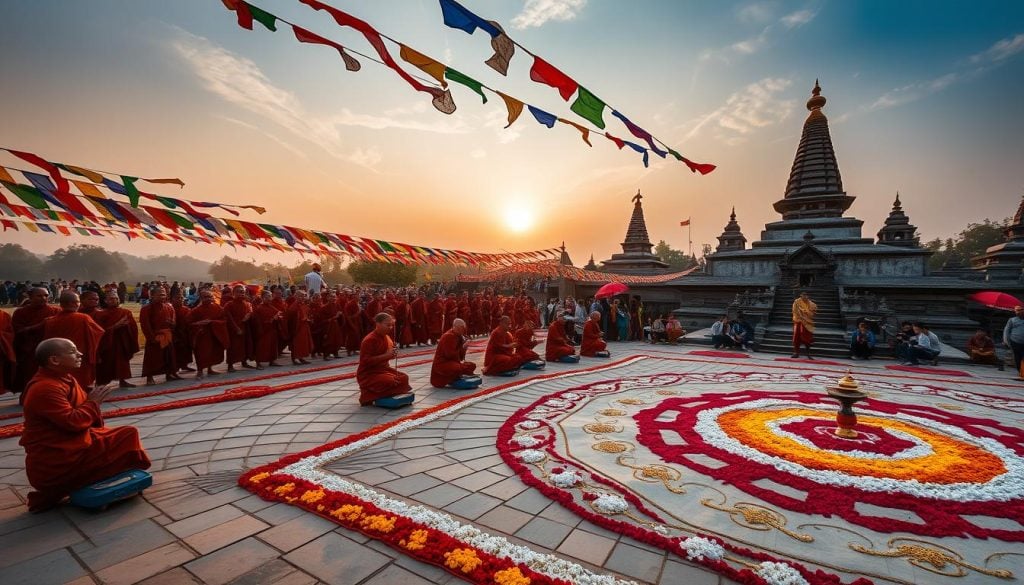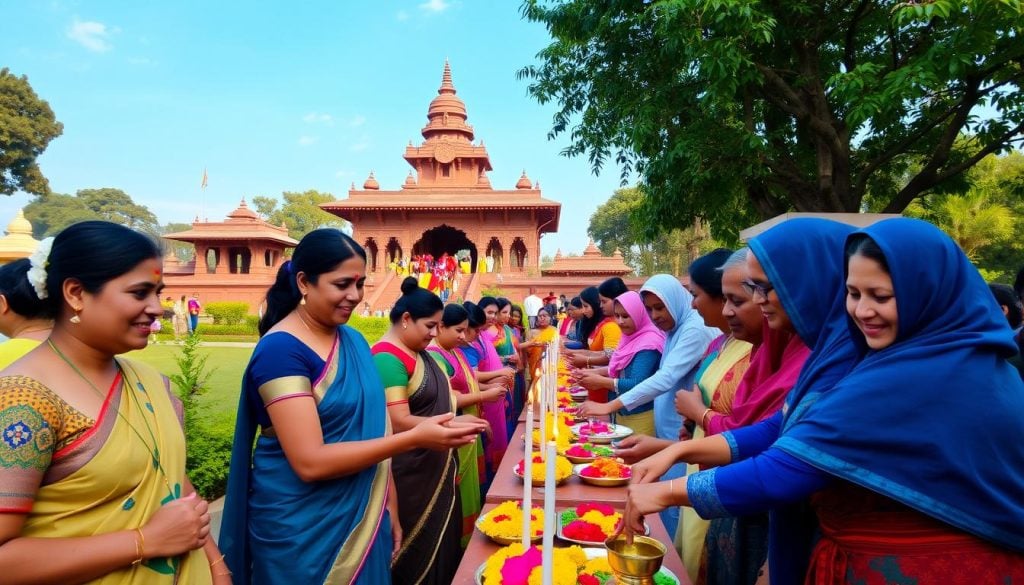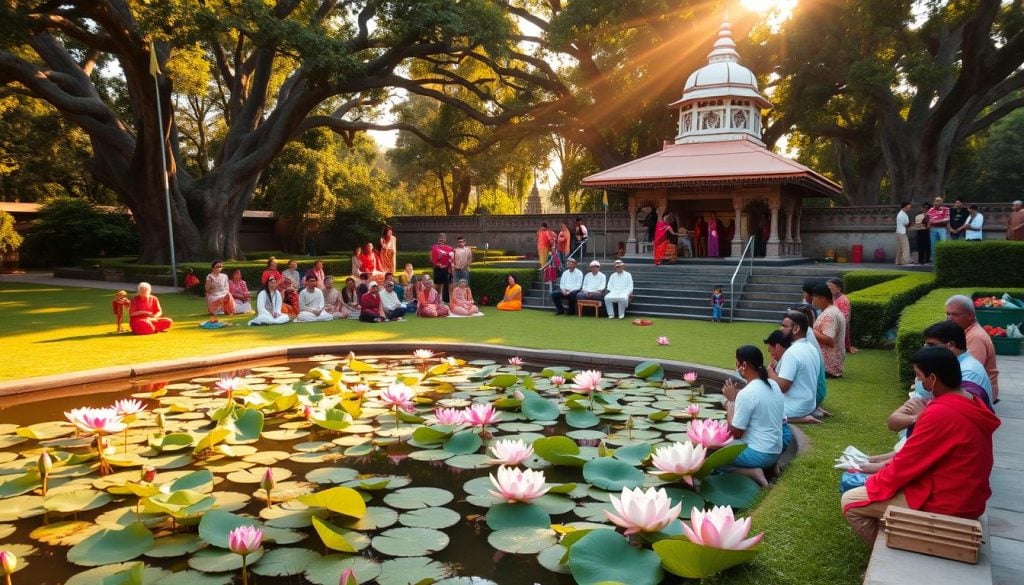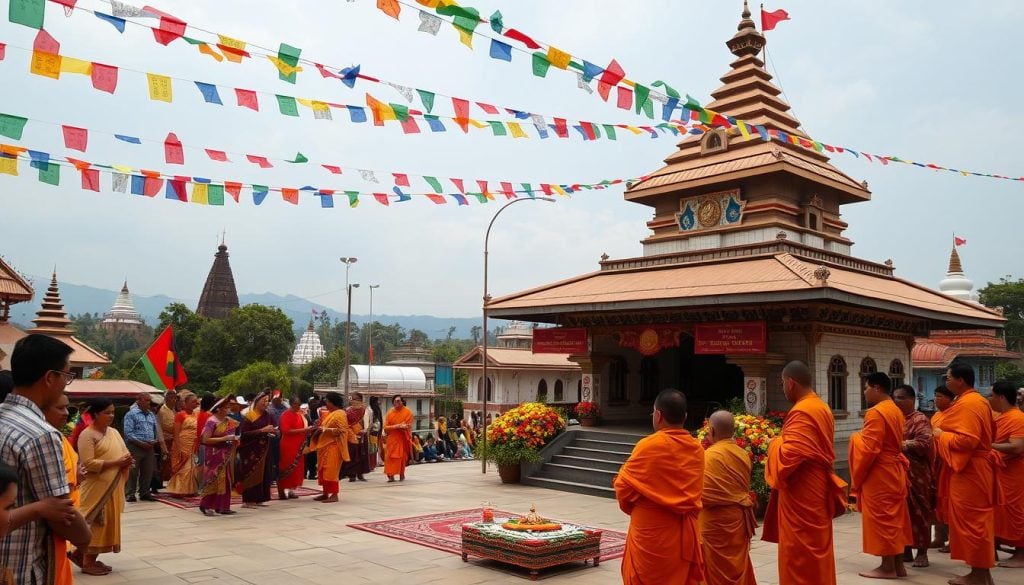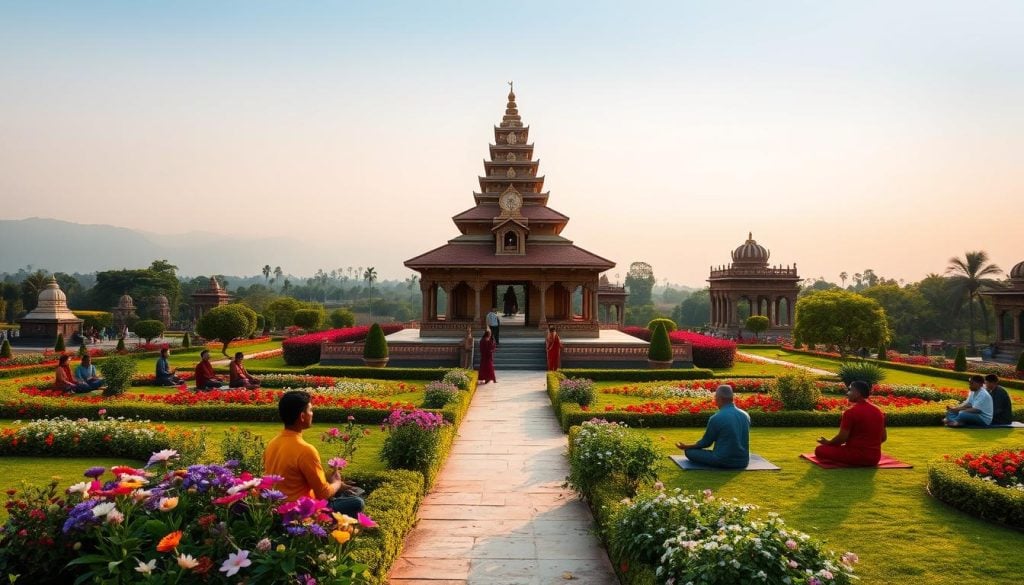Ever wondered what it’s like to join ceremonies that have shaped a religion for ages? Lumbini, the birthplace of Lord Buddha and a UNESCO World Heritage Site, offers a deep dive into Buddhism. This guide helps you understand how these rituals connect you to centuries of spiritual tradition and cultural importance.
Millions of pilgrims visit each year, making it a unique chance to learn about Buddhism. Whether you’re interested in the intensity of pilgrimage rituals or the calm of meditation, Lumbini welcomes you. It invites you to reflect, engage, and join its lively spiritual community.
Introduction to Lumbini
Lumbini is in the Rupandehi district of Nepal. It’s famous as the birthplace of Buddha. Every year, millions visit to find enlightenment and learn about Buddhism.
The town’s spiritual vibe is perfect for meditation and self-reflection. Walking through the gardens and seeing old monuments, you feel the history. Each spot has temples that show Buddha’s teachings.
Participating in local ceremonies deepens your connection to Lumbini’s spirit. It’s a special place for those seeking spiritual growth.
Historical Significance of Lumbini
Lumbini is a key pilgrimage site for Buddhists worldwide. It is where Siddhartha Gautama, known as Buddha, was born in 563 BC. This place is filled with stories of Buddha’s life, showing centuries of faith and devotion.
The history of Lumbini is ancient and filled with devotion. People travel here to feel the spiritual essence. The Ashoka Pillar, built in the 3rd century BC, stands as a symbol of Buddha’s teachings.
Visiting Lumbini lets you understand its rich culture and traditions. It shows how Buddha’s life has shaped rituals and traditions that continue today.
The Role of Ceremonies in Buddhism
Ceremonies in Buddhism are very important. They help people show their devotion, build community, and think deeply about their beliefs. In different Buddhist cultures, these ceremonies have their own special ways and meanings.
In Lumbini, there are many religious rituals. These include pujas, chanting mantras, and silent meditation. These activities help people connect with the heart of Buddhist teachings.
Buddhist ceremonies are more than just old traditions. They help people be more mindful and aware. By taking part in these rituals, you can really feel the depth of Buddhist heritage. This makes your visit to Lumbini even more meaningful.
| Aspect | Importance |
|---|---|
| Community Bonding | Encourages collective participation and shared experiences. |
| Devotional Practices | Deepens personal faith through acts of worship. |
| Spiritual Growth | Promotes self-awareness and mindfulness. |
| Cultural Transmission | Preserves traditions and teachings for future generations. |
Exploring Sacred Ceremonies in Lumbini
Lumbini is a vibrant center of Buddhist practices. It shows the richness of different traditions through its sacred ceremonies. These ceremonies let you dive into the spiritual vibe and connect with old teachings. You can join in at many monasteries and temples, making your experience unique.
Visitors can take part in rituals like prayer offerings, chanting, and meditation. These activities deepen your bond with Buddhism. They also give you a peek into the lives of those who follow these traditions. Talking with local monks and practitioners helps you understand the rituals’ meaning.
The ceremonies in Lumbini show the heart of Buddhist spirituality. They let you see and join in the rich cultural mix of Lumbini. Plan your visit to catch these sacred events and grow spiritually.
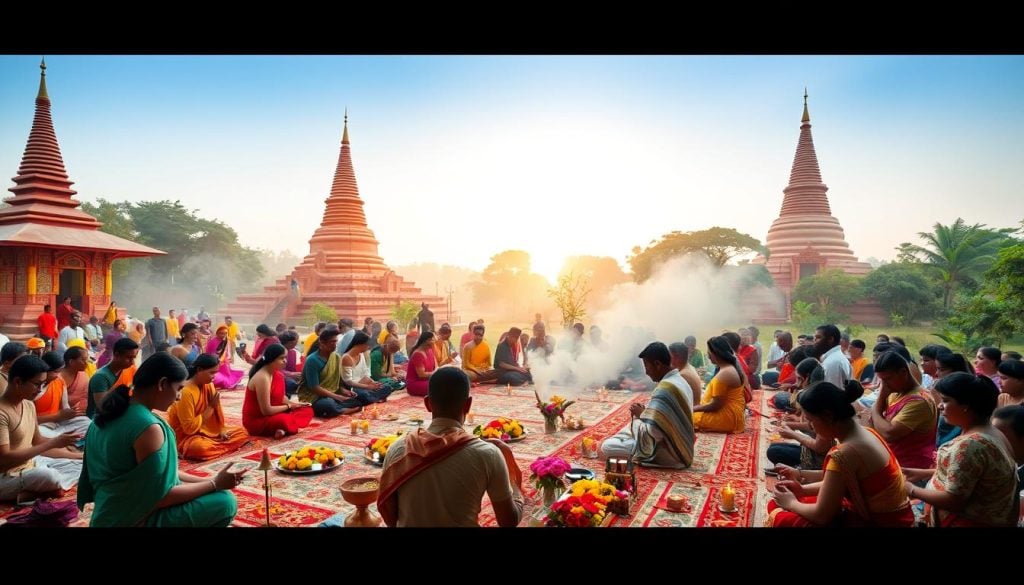
| Type of Ceremony | Description | Location |
|---|---|---|
| Prayer Offerings | Participate in rituals where offerings are made to deities, emphasizing gratitude and devotion. | Maya Devi Temple |
| Chanting Sessions | Join local monks in chanting sacred texts for peace and enlightenment. | Various Monasteries |
| Meditation Retreats | Engage in guided meditation sessions that focus on mindfulness and awakening. | Sun Temple |
| Candle Lighting | Experience the serene practice of lighting candles as a symbol of hope and compassion. | Siddhartha Garden |
Participating in Ceremonies in Lumbini
Joining in Lumbini’s ceremonies gives you a special look into Buddhism’s spiritual traditions. You’ll see many ceremonies that connect you with Buddha’s birthplace’s deep history and beliefs.
Ceremonial Traditions You Can Experience
In Lumbini, you can dive into ancient practices. Puja ceremonies at monasteries let you see monks chant and make offerings. These rituals bring people together and deepen your spiritual journey. Some key traditions include:
- Puja Ceremonies: Involve chanting and offerings by monks.
- Rituals of Blessing: Community events where blessings are shared.
- Group Meditations: Focused sessions in serene environments.
Spiritual Events to Attend
Spiritual events in Lumbini draw visitors worldwide. These events offer a chance to meet others on a spiritual path. Celebrations like Vesak mark important moments in Buddha’s life. Here are some events you might find enriching:
| Event | Date | Description |
|---|---|---|
| Vesak | May (exact date varies) | Celebrates Buddha’s birth, enlightenment, and passing. |
| Buddha Jayanti | April (exact date varies) | A festival celebrating the life of Buddha with various activities. |
| Meditation Retreats | Year-round | Intensive sessions focusing on mindfulness and meditation practices. |
Major Sites for Ceremonies in Lumbini
Exploring Lumbini’s major sites for ceremonies is key to understanding its spiritual depth. Each site has deep meaning, drawing pilgrims and visitors globally. Here are two standout sites that showcase Lumbini’s rich history and ongoing spiritual practices.
Maya Devi Temple
The Maya Devi Temple is a top pilgrimage site in Lumbini, marking the birthplace of Siddhartha Gautama, the Buddha. It’s not just significant historically but also for its ongoing ceremonies. Visitors participate in prayers, offerings, and meditation, creating a profound spiritual connection.
Ashoka Pillar
Close to the Maya Devi Temple, the Ashoka Pillar is a key part of Buddhist history. Emperor Ashoka built it in the third century BCE. The pillar’s inscriptions confirm Lumbini as the Buddha’s birthplace. It’s a major site for ceremonies, offering inspiration and reverence to all who visit.
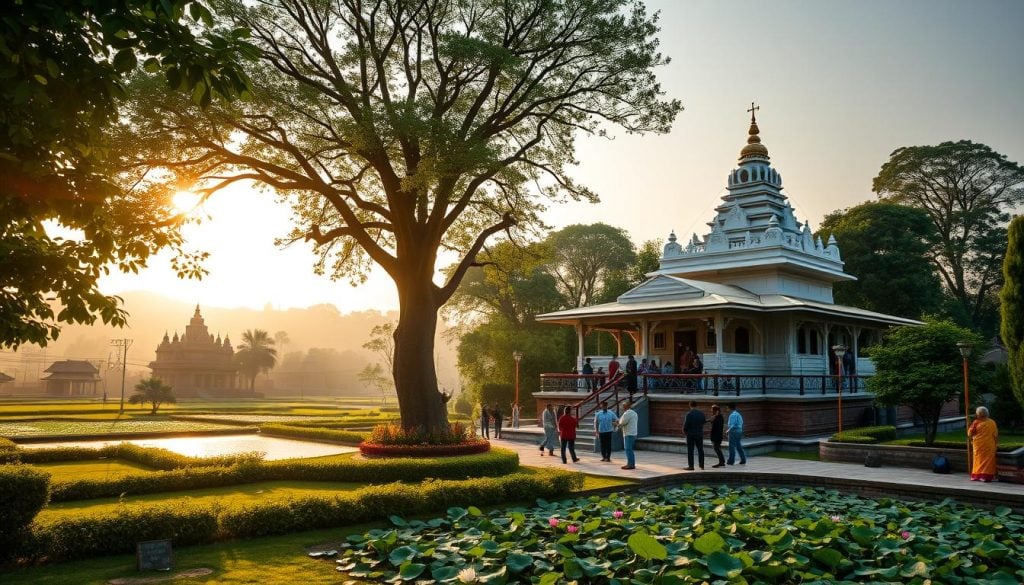
Understanding Lumbini Pilgrimage Rituals
Lumbini is a place of enlightenment, where pilgrims find deep connections to Buddhist teachings. These rituals are part of spiritual journeys in Lumbini. They help deepen personal reflection and spiritual growth. People from all over the world come here to practice Buddhist pilgrimage practices, each with its own meaning.
One key ritual is walking around the Maya Devi Temple. It’s a mindful journey around Buddha’s birthplace. It brings pilgrims together in unity and devotion. Many also meditate in the Sacred Garden, a peaceful spot for reflection.
Lumbini pilgrimage rituals are more than just personal reflection. They create a bond among pilgrims, fostering mutual respect and devotion. By participating, you connect with a long tradition that links the past to the present. You immerse yourself in Buddhism’s spiritual essence.
| Ritual | Description | Significance |
|---|---|---|
| Circumambulation | Walking around the Maya Devi Temple | Symbolizes reverence to Buddha’s birthplace |
| meditation | Contemplative practice in the Sacred Garden | Promotes inner peace and mindfulness |
| Offerings | Presenting flowers or candles at sacred sites | Expresses gratitude and devotion |
| Chanting | Reciting Buddhist prayers | Enhances spiritual connection within the community |
Cultural Ceremonies in Lumbini, Nepal
Lumbini is famous as the birthplace of Buddha. It has a rich mix of cultural ceremonies that show its diverse heritage. Visitors can dive into various cultural ceremonies in Lumbini, Nepal. These highlight local traditions and shared Buddhist values.
These events are more than just celebrations of spiritual beliefs. They also show off Lumbini’s lively community.
Joining in these events is a special chance to connect with others. You’ll see the beauty of Lumbini’s traditional practices. Festivals often include:
- Traditional music that brings a lively atmosphere to the surroundings.
- Cultural dances that tell stories and convey messages from the past.
- Delicious local cuisine that reflects the rich culinary heritage of the area.
By taking part in Lumbini cultural experiences, you learn more about the community’s values and history. These ceremonies entertain and educate. They help visitors make lasting memories and connections.
Planning Your Visit to Experience Ceremonies
When you plan your trip to Lumbini, timing is key for a rich ceremony experience. Knowing the best times for ceremonies lets you dive deep into the local culture. Festivals draw big crowds, creating a lively atmosphere perfect for joining in.
Best Times for Participation
Look up the local ceremonial calendar to find the year’s highlights. Festivals like Buddha Jayanti and Vesak are big draws. They’re great times to connect with Lumbini’s customs and traditions.
What to Bring for Your Ceremony Experience
For a great ceremony experience, pack the essentials. Wear comfy clothes for temple visits. Bring a meditation cushion for seated ceremonies. Don’t forget personal offerings like flowers or candles to show respect and add a personal touch.
| Event | Date | Best Time to Visit |
|---|---|---|
| Buddha Jayanti | Varies (April/May) | Days leading up to the event |
| Vesak | Varies (April/May) | Evening ceremonies |
| Magha Puja | Varies (February) | Early morning ceremonies |
| Ashvin Purnima | Varies (September/October) | Full moon nights |
Conclusion
Reflecting on your time in Lumbini, you’ll see the special chance to dive into rituals. These connect you to Buddha’s teachings and the local community’s spirit. The Lumbini ceremony experience gives deep insight into the site’s traditions.
Being part of Lumbini lets you see the rich cultural and spiritual life in these ceremonies. Every moment of shared intentions and mindfulness deepens your understanding of our search for meaning and enlightenment.
The memories from Lumbini will stay with you long after you leave. The ceremonies you attend will inspire you on your journey to inner peace and connection with the world.

































